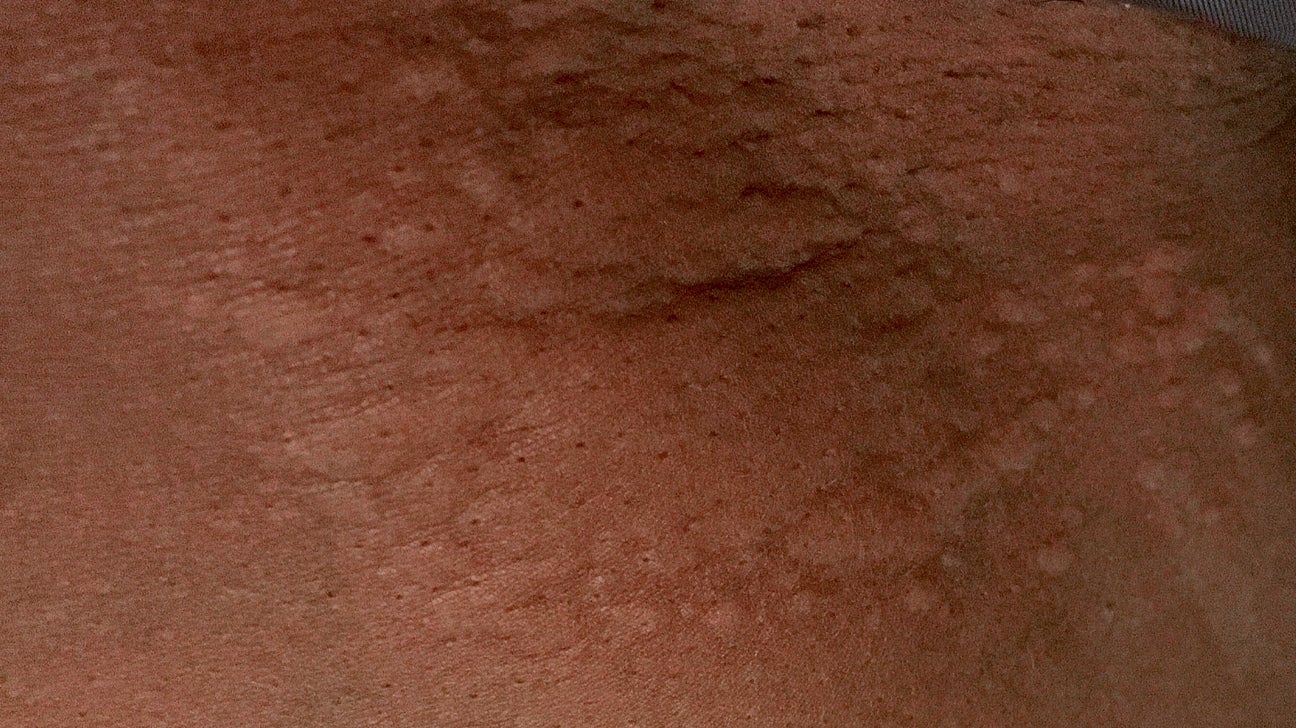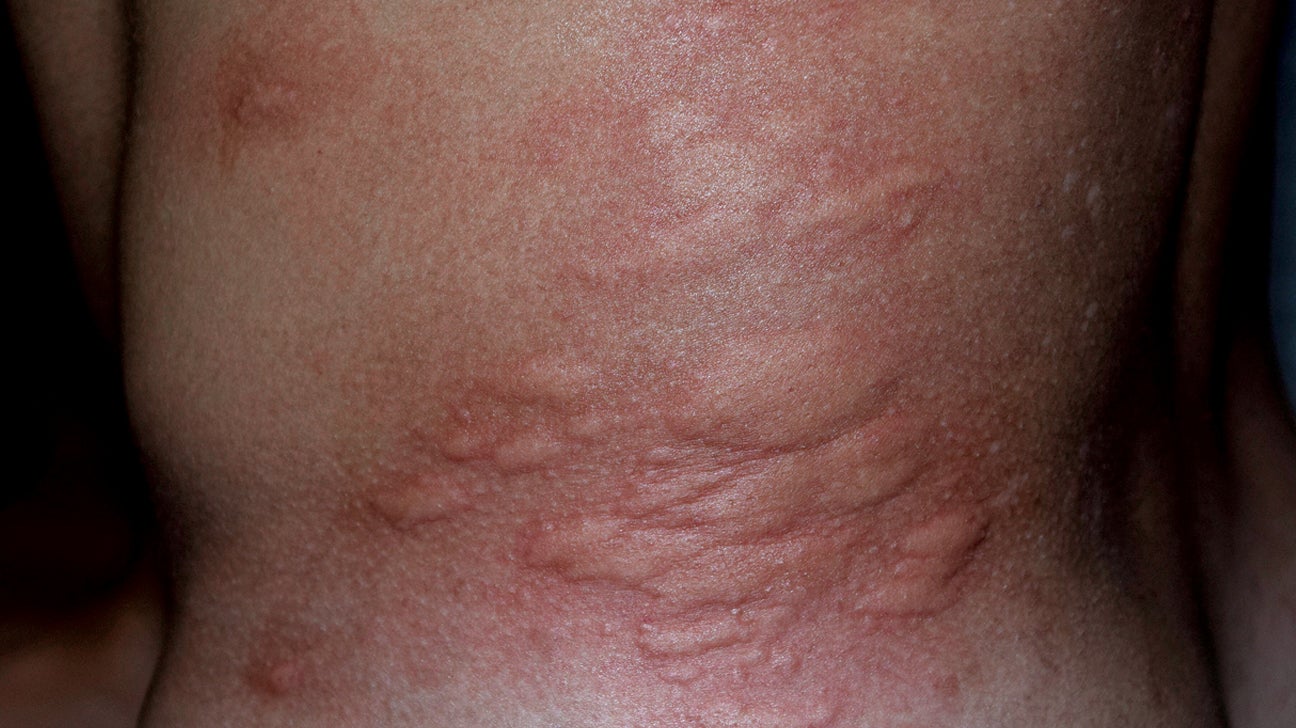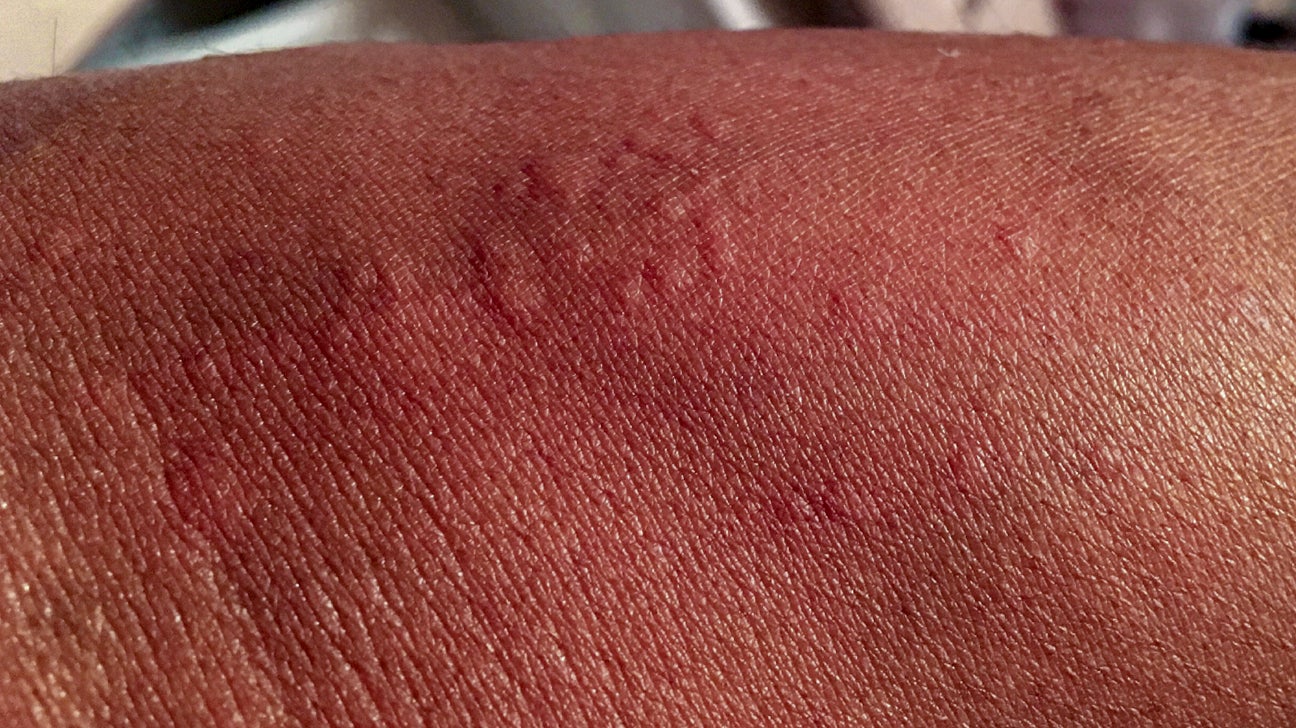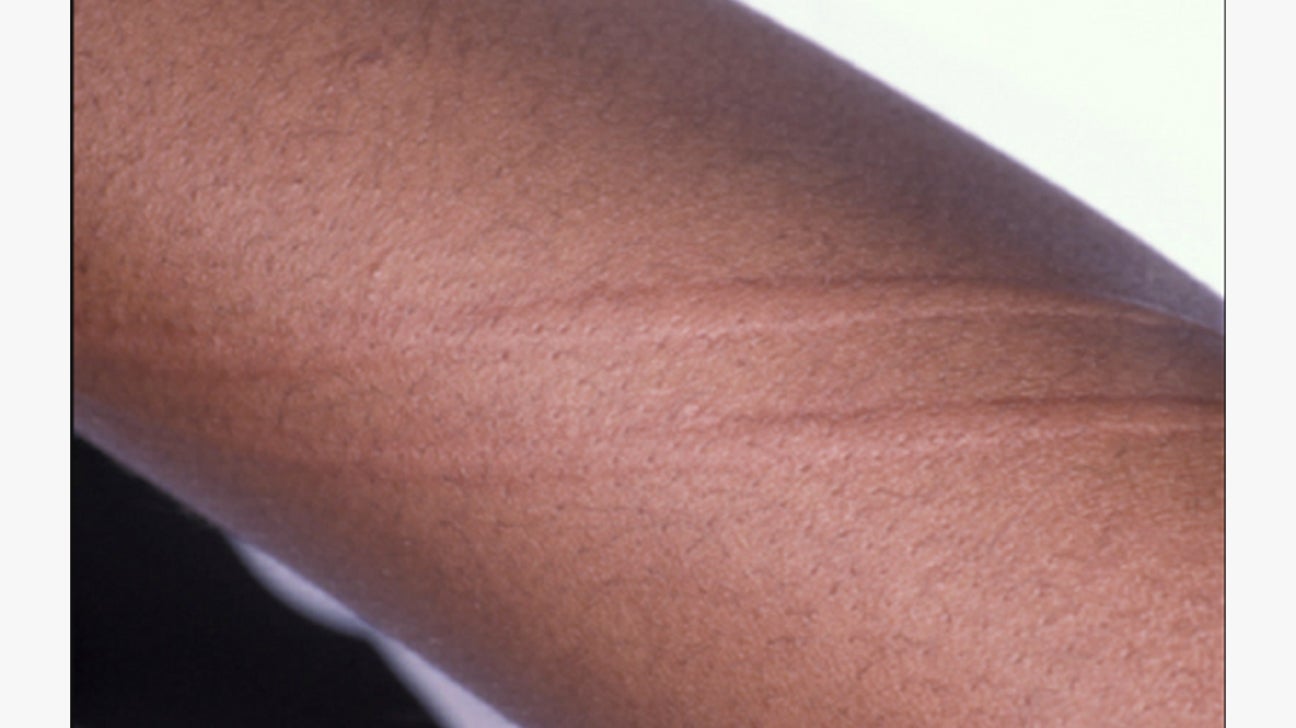If you do a quick image search for hives, you’ll mostly see what they look like on light skin tones. The problem is, hives can look a lot different on dark skin.
Hives on black skin FAQs
- What do hives look like? Hives on black skin often look like inflamed or raised spots, but they won’t always look red. They’ll typically match the color of the surrounding skin.
- What causes hives? Like any skin tone, hives on black skin are typically caused by the environment or an allergy. Sometimes the cause is unknown.
- How can you treat hives? Your doctor may suggest an OTC antihistamine or prescribe you a stronger antihistamine or medication. Home remedies like a cold compress or cool bath might also help symptoms.
Here’s what to know about identifying and getting medical attention for hives on darker skin tones.

Hives on black skin: Pictures and details
Symptoms of hives across all skin tones include:
- a round, oval, or squiggly shape
- raised areas
- itchiness and tenderness
- occurrence in isolated groups or over large areas
But hives on dark skin don’t typically appear red or pink, instead they’re often closer in color to the surrounding skin. These hives will appear slightly lighter or darker, but the difference isn’t as stark as it is on white skin. Hives on black skin will still look irritated and inflamed, but their pigment can vary widely.
Here’s a closer look:
Unfortunately, many medical students aren’t always taught how to diagnose skin conditions on Black patients. As a result, hives and other skin conditions on patients with black skin are often misdiagnosed by medical professionals.
According to a 2020 study, 200+ medical students were worse at diagnosing skin cancer, eczema, and hives in skin of color (SOC) compared to white skin. Only about 57 percent of students correctly identified hives in skin in color.
Common hive triggers
Hives are often triggered by something from your environment or an allergy. Common triggers include:
- eating certain foods
- taking certain meds
- contact with an allergen (like latex)
- working out
- high stress levels
- blood transfusions
- bacterial infections (like UTIs or strep)
- viral infections (like the common cold)
- pet dander
- pollen
- some plants
Sometime hives pop up for no apparent reason. According to 2018 research, in about half of patients with hives, the cause is unknown.
Got hives? Here are the main types to know about
Hives often crop up due to something the skin comes into contact with, whether it’s shellfish, pollen, or pet dander. This is called contact urticaria.
There are three main types of hives you can get:
- immunologic contact hives
- nonimmunologic contact hives
- unknown mechanism contact hives
Here are the deets.
1. Immunologic contact hives (allergic triggers)
Immunologic reactions occur due to an allergy triggering an immune system response. These can be really serious and spread across large areas of skin.
Allergic triggers often include:
- veggies, nuts, fruits, or spices
- meat, dairy, or eggs
- shellfish or fish
- grains like wheat, barley, or rye
- insect stings or bites
- airborne allergens like pollen, mold, and pet dander
- certain types of medications, like penicillin, sulfonamides, nonsteroidal anti-inflammatory drugs (NSAIDs), ACE inhibitors, morphine, and codeine
- contact allergens like latex
A reaction goes down when chemicals like histamine let loose in response to a trigger. Over time, continuous exposure to a trigger can make the reaction worse.
These reactions often occur in stages:
- Stage 1: swelling, burning, itching and potentially redness at the contact point
- Stage 2: hives that spread from the initial contact point
- Stage 3: symptoms like asthma, swollen/red eyes, nausea, or difficulty swallowing
- Stage 4: anaphylaxis (a potentially life-threatening allergic reaction that can lead to anaphylactic shock)
Anaphylactic shock 101
Anaphylaxis happens when your body’s immune system overreacts to an allergen. This can trigger a severe drop in blood pressure and lead to anaphylactic shock. Anaphylactic shock is a serious and potentially life-threatening medical emergency.
If you or someone you know has symptoms of anaphylactic shock, call 911 ASAP.
Anaphylactic shock symptoms can include:
- nose, mouth, skin, or stomach irritation (like hives, congestion, or diarrhea)
- breathing difficulties (like wheezing)
- faintness, dizziness, or confusion
- a feeling of doom or terror
- rapid heart rate
- mouth, tongue, lip, or throat swelling
- lip or mouth color changes (in black skin, they might change to whiteish or grayish)
- a feeling of being choked or difficulty swallowing
2. Nonimmunologic contact hives (nonallergic triggers)
Nonimmunologic contact hives don’t happen due to an immune system response from an allergy. These tend to be more common and fortunately, less intense. Hives tend to only show up at the site of contact.
Some common triggers for nonimmunologic hives include:
- animals and bugs
- food and spices like pepper, mustard, or thyme
- fragrance (especially from spicy scents thanks to the acid in cinnamon)
- meds like benzos, camphor, or witch hazel
- metals like cobalt and nickel
- plants like stinging nettle or seaweed
- preservatives like formaldehyde or benzoic acid (often used in perfumes and topical meds)
- environmental triggers like sun exposure and extreme temps
- skin contact from pressure or scratching
- high stress levels
- working out
- viral infections like the common cold, infectious mononucleosis, and hepatitis
- bacterial infections like strep throat and urinary tract infections (UTIs)
- health conditions like lupus, rheumatoid arthritis, thyroid disease, certain cancers, and vasculitis
Note: There’s some overlap between the two types of these nonallergic triggers and allergic triggers.
3. Unknown mechanism contact hives
Sometimes, a doctor can’t actually tell whether hives happen due to immunologic or nonimmunologic factors. An example of this is when people break out in hives due to ammonium persulfate, a common trigger found in some rubbers.
These oddballs end up falling into a category all their own: unknown mechanism contact hives. Basically, the science just isn’t there yet to know what’s causing these hives.
How to treat hives on black skin
Treatment for hives depends on whether they’re acute (an isolated or short-term issue) or chronic (an ongoing prob). Always chat with your doc about the best steps to take when hives pop up.
Here’s what your doc might suggest.
Treating acute hives
Doctors may recommend you take an over-the-counter (OTC) antihistamine (like Zyrtec) to treat isolated hives.
If they don’t go away, any of the following might go down:
- If the issue is serious, your doctor might recommend taking 2 to 4 times the regular dose.
- If this doesn’t do the trick, another antihistamine might be recommended.
- A 3 to 10 day course of corticosteroids might also be prescribed when hives are severe.
- If you’re at risk of anaphylactic shock, your doctor will likely prescribe an epinephrine auto-injector, aka an EpiPen.
Treating chronic hives
Chronic hives are an ongoing problem and typically call for a more intense treatment plan:
- First, your doctor will likely prescribe a daily antihistamine. If this doesn’t work, they might recommend you take 2 to 4 times the regular dose.
- Hives still not subsiding? Then they might prescribe another medication like montelukast (aka an asthma med), or an OTC antihistamine like diphenhydramine (aka Benadryl) before you tuck in for the night.
- If the hives still thrive, they might prescribe a stronger antihistamine like hydroxyzine (aka Atarax).
- Still swelling up like a balloon? Then they might have to refer you to a specialist who can prescribe you cyclosporine or omalizumab (Xolair, aka an immunosuppressant).
- As soon as the hives go down, your doc may recommend lowering your dosage.
- For the occasional flare-up of chronic hives, your doc may recommend another 3 to 10 day course of corticosteroids.
Home remedies for hives
For a little at-home TLC, you can try some of these remedies to ease symptoms:
- Keep it cool with a cool compress. Help ease itching and irritation with a cold pack.
- Keep it even cooler with a cool bath. If your hives cover a lot of your bod, you may want to hop into a cool bath.
- Take a break from triggers. Keep triggers at bay while your hives heal.
- Wear comfy clothes. Nothing’s worse than chafing + hives. Stick to your comfiest sweats to ride this one through.
- Srsly, don’t scratch. It’s so hard not to, but resist the urge to scratch, which can cause further irritation and increase the risk of long-term pigmentation changes.
- Sorry, but stay out of the sun. The sun’s rays can worsen hyperpigmentation from hives. If you must go in the sun, cover them up, or at least wear sunscreen.
When to see a doc about your hives
Fortunately, hives often go away with home remedies and OTC antihistamines. If those don’t work or you hives become severe, it’s time to see a doc.
Talk to your doctor if:
- hives last longer than a few days
- hives are severe (i.e. painful, blistering) or cover a big area of your body
- you think an allergy triggered your hives
Remember, call 911 if you think you or someone else is experiencing shortness of breath or face swelling, which can signal anaphylaxis.
Finding the right provider
While all docs *should* be trained to address skin concerns for all skin types, that’s not always the case.
To get the best care, see medical professionals who are trained to identify skin conditions on black skin.
Here are a few resources to find a doc who specializes in skin of color:
- The American Academy of Dermatology (AAD). The AAD has a search tool to help you find nearby derms. Use the filter under “Practice Focus” to find a provider that specializes in skin of color.
- Skin of Color Society (SOCS). The SOCS aims to boost awareness of dermatologic conditions in skin of color. They have a big searchable list of qualified dermatologists.
Takeaway
Hives on black skin might vary only slightly or not at all in pigmentation compared to the surrounding skin. This can make it more challenging to notice at a glance.
Plus, many doctors aren’t trained to identify hives on dark skin tones, which can lead to misdiagnosis. If you think you have hives, find a dermatologist who specializes in dark skin to get the quality care your skin deserves.
Most of the time, hives clear up on their own. But, talk with your doctor if your hives:
- last longer than a few days
- cover a large expanse of your body
- are painful or severe
- are triggered by an allergen
Hives and an extreme reaction? Call 911 ASAP
If you’re experiencing shortness of breath or swelling of the throat, mouth, or face in addition to your hives, call 911 right away — you could be experiencing anaphylactic shock.






0 Commentaires